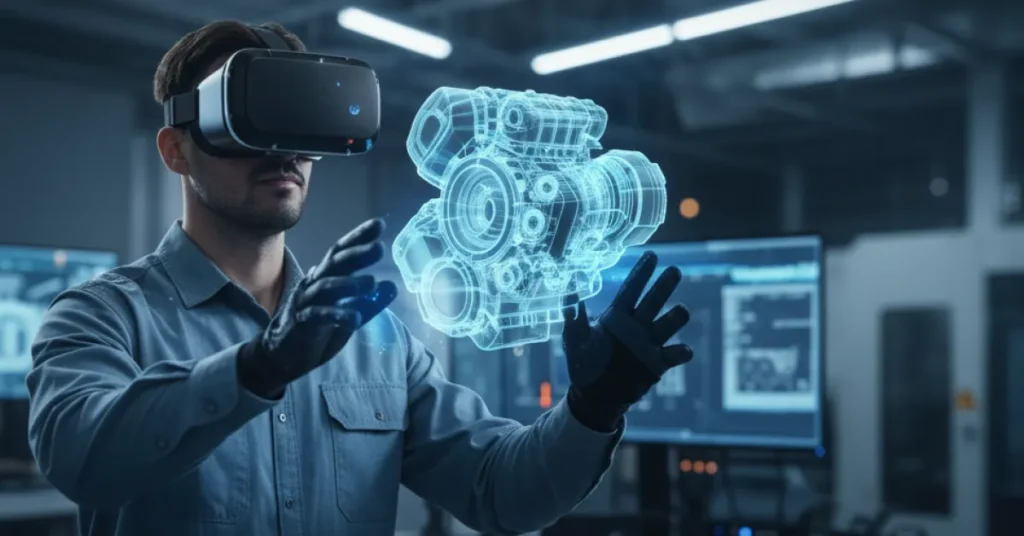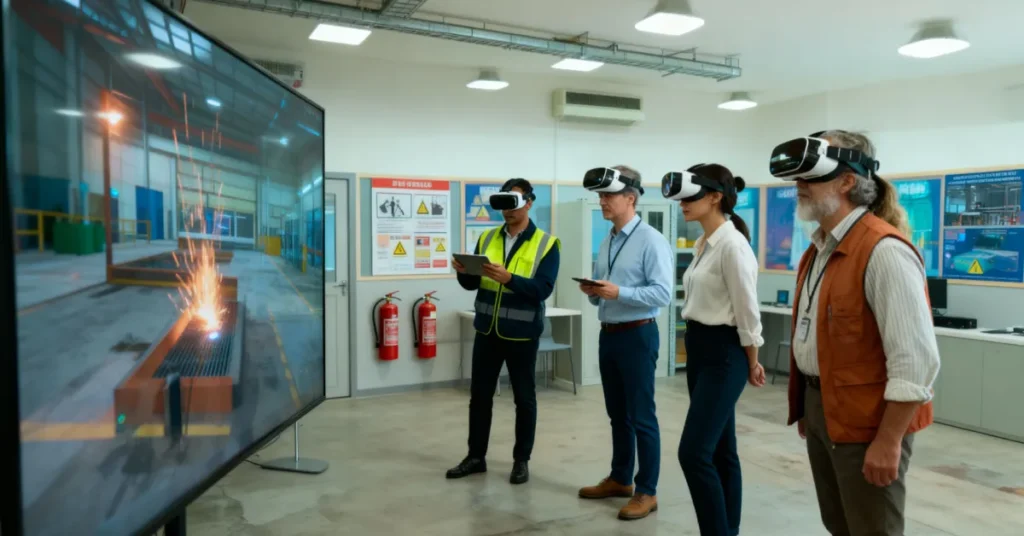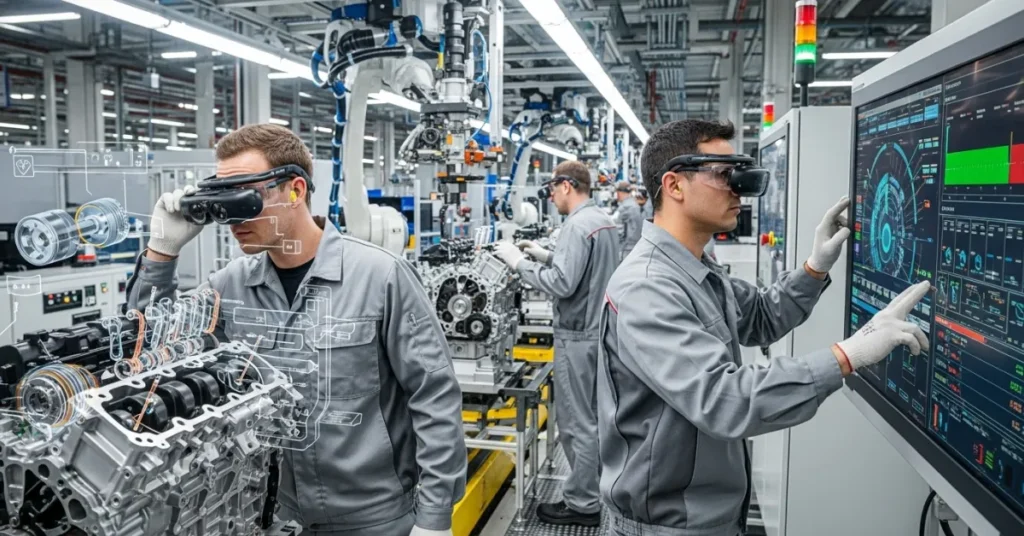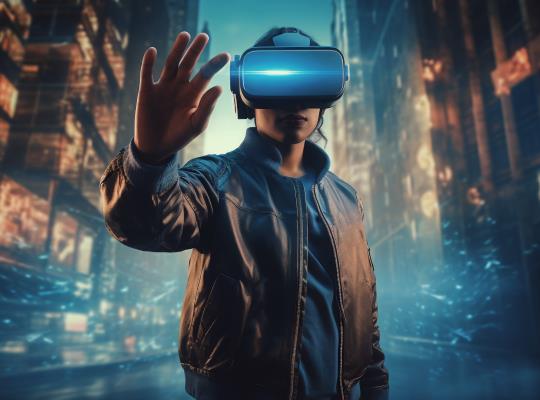The manufacturing industry is entering a new era — one where precision, innovation, and immersive technology define competitiveness. As industries evolve toward digital transformation, one question stands out: how could the manufacturing sector utilize extended reality?
The answer lies in how extended reality (XR) — a collective term for virtual reality (VR), augmented reality (AR), and mixed reality (MR) — can seamlessly merge physical and digital processes. By bringing visualization, collaboration, and interactivity into everyday manufacturing operations, XR in manufacturing industry settings is redefining the way design, production, and maintenance are done.
For forward-thinking manufacturers, understanding how the manufacturing sector could utilize extended reality is not a matter of “if” but “how fast.” And with the expertise of a professional XR company like Quantile Corp, businesses can integrate tailored XR solutions that deliver measurable, long-term value.
Table of Contents
Understanding How Extended Reality Fits into Manufacturing
To understand how the manufacturing sector could utilize extended reality, it’s important to see XR not as a futuristic concept, but as a strategic enabler of efficiency and innovation. XR integrates digital elements into real-world manufacturing environments, allowing teams to visualize data, simulate workflows, and interact with 3D models in ways that were never before possible.
Bridging Physical and Digital Workspaces
Extended reality helps bridge the physical and digital worlds. Engineers can now view designs virtually, test changes instantly, and even walk through a digital factory before anything is built physically. This digital-physical synchronization allows faster and smarter decision-making.
A Scalable Digital Transformation Tool
XR is adaptable to multiple manufacturing domains — from automotive and aerospace to consumer electronics and heavy engineering. Whether used for training, quality control, or design validation, XR offers a scalable foundation for future-ready manufacturing.
Data-Driven Decision Making
Modern manufacturing depends on real-time data. Extended reality visualizes machine data, production metrics, and performance analytics right in the operator’s view, creating a more intuitive and data-driven decision environment.
Practical Ways the Manufacturing Sector Can Utilize Extended Reality
The next step in exploring how could the manufacturing sector utilize extended reality is understanding its practical, day-to-day use cases. XR is not a single technology but a set of tools designed to optimize processes, enhance workforce performance, and improve operational safety.

XR for Design and Prototyping
One of the most valuable applications of XR in manufacturing industry environments is during the design and prototyping stage.
- Engineers can visualize 3D product models at scale and interact with them in immersive spaces.
- XR reduces dependence on physical prototypes, saving both time and material costs.
- Real-time collaboration between designers, engineers, and stakeholders ensures alignment before production begins.
A professional XR company like Quantile Corp develops XR solutions that help manufacturers validate designs virtually, reducing product errors and accelerating time to market.
XR for Assembly and Production Guidance
Another key way the manufacturing sector utilizes extended reality is through assembly and production assistance.
- Workers equipped with AR headsets receive step-by-step digital overlays of assembly instructions.
- XR visual guidance ensures consistency and accuracy across shifts and teams.
- Even complex tasks can be executed with reduced training time and minimal supervision.
This hands-on, visual learning approach improves workforce performance and reduces operational downtime.
XR for Maintenance and Equipment Servicing
When machines fail, downtime costs escalate rapidly. Extended reality minimizes these disruptions.
- Maintenance technicians can access remote expert assistance through XR headsets.
- Step-by-step repair instructions appear directly in their field of view.
- Predictive maintenance powered by digital twins helps identify potential issues before they occur.
This is one of the most direct answers to how the manufacturing sector could utilize extended reality — through maintenance efficiency and operational resilience.
XR in Workforce Training and Safety Management

One of the strongest arguments for XR in the manufacturing industry lies in how it transforms employee training and safety. Traditional methods can be costly, risky, and inconsistent. Extended reality changes that by offering realistic, immersive simulations that are both safe and repeatable.
Immersive Skill Training
XR enables new hires and technicians to practice complex procedures in simulated environments before entering the production floor. Mistakes can be made — and corrected — without real-world consequences.
This approach improves learning retention and confidence while lowering training costs.
Safety Scenario Simulation
Safety is non-negotiable in manufacturing. XR recreates hazardous scenarios such as equipment malfunctions, chemical leaks, or emergency evacuations, allowing employees to respond effectively.
Through repetition and interactivity, workers internalize safety procedures far more effectively than through manuals or videos.
Continuous Upskilling Through XR Solutions
As machinery evolves, so must employee skills. With XR solutions from experienced providers like Quantile Corp, training modules can be updated and deployed instantly across locations. This ensures a consistent learning experience and prepares workers for rapidly changing technologies.
The Strategic Role of XR Companies in Manufacturing Transformation
To truly understand how the manufacturing sector could utilize extended reality, we must recognize the importance of collaboration with experienced technology partners. Implementing XR is not about adding a new gadget — it’s about rethinking operations for the digital age.

Custom-Built XR Solutions for Industry Needs
Each manufacturing setup is unique. The machinery, processes, and workforce differ from one plant to another. A professional XR company like Quantile Corp tailors XR solutions to fit specific operational needs — from real-time monitoring to immersive simulation and digital twin integration.
Enhancing Collaboration Across Global Teams
Manufacturers often have distributed teams across continents. XR makes remote collaboration seamless by allowing engineers, designers, and production managers to work together in shared 3D spaces — regardless of location.
This drastically reduces communication gaps and speeds up decision-making cycles.
Supporting Sustainable Manufacturing
Sustainability is another emerging benefit of extended reality. By reducing waste from prototyping, cutting energy use, and minimizing travel through virtual collaboration, XR contributes directly to eco-efficient manufacturing strategies.
Building Future-Ready Manufacturing Ecosystems
The manufacturing sector utilizes extended reality to prepare for future industrial challenges — automation, labor shortages, and global supply chain fluctuations. XR integrates seamlessly with Industry 4.0 technologies such as IoT, AI, and robotics, enabling smarter, more connected factories.
Conclusion
So, how could the manufacturing sector utilize extended reality? The answer is through a deliberate and strategic embrace of immersive technology — one that bridges the gap between digital design and physical production.
From virtual prototyping to real-time collaboration, from training and safety simulations to predictive maintenance, extended reality is transforming manufacturing into a more agile, efficient, and sustainable industry.
However, realizing the full potential of XR in manufacturing industry settings requires the expertise of an experienced XR company. That’s where Quantile Corp comes in — delivering XR solutions tailored to help manufacturers innovate, optimize, and lead in an increasingly competitive global market.
The future of manufacturing is immersive — and extended reality is the bridge that connects vision to execution.



